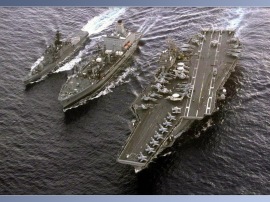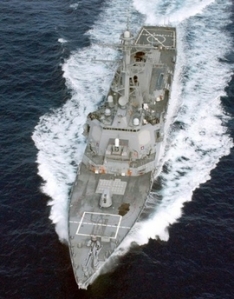Fake ‘slam dunk’ intelligence for War with Iran
November 30, 2010
Mysterious “Laptop Documents”. used to Justify a Pre-emptive Nuclear War on Iran
Michel Chossudovsky
Global Research
The UN Security Council on June 9 2010 adopted the imposition of a fourth round of sweeping sanctions against The Islamic Republic of Iran. UNSC Resolution 1929 includes an expanded arms embargo as well as “tougher financial controls”:
“[Resolution 1929 (June 9, 2010)] Decides that all States shall prevent the direct or indirect supply, sale or transfer to Iran, from or through their territories or by their nationals or individuals subject to their jurisdiction, or using their flag vessels or aircraft, and whether or not originating in their territories, of any battle tanks, armoured combat vehicles, large calibre artillery systems, combat aircraft, attack helicopters, warships, missiles or missile systems …. , decides further that all States shall prevent the provision to Iran by their nationals or from or through their territories of technical training, financial resources or services, advice, other services or assistance related to the supply, sale, transfer, provision, manufacture, maintenance or use of such arms and related material, and, in this context, calls upon all States to exercise vigilance and restraint over the supply, sale, transfer, provision, manufacture and use of all other arms and related material;” (Security Council Imposes Additional Sanctions on Iran, Voting 12 in Favour to 2 Against, with 1 Abstention, Includes complete text of UNSC Resolution 1929, UN News, June 9, 2010, emphasis added, )
Both the Russian Federation and the People’s Republic of China caved in to US pressures and voted in favor of UNSC Resolution 1929. In November, following a decree issued by president Dmitry Medvedev, Moscow announced the cancellation of its military cooperation agreement with Iran pertaining to the S300 air defense system.
Without Russian military aid, Iran is a “sitting duck”. Its air defense system depends on continued Russian military cooperation.
These developments strike at the very heart of the structure of military alliances. They prevent Russia and China to sell both strategic and conventional weapons and military technology to their de facto ally: Iran. In fact, that was one of major objectives of Resolution 1929, which Washington is intent upon enforcing.
Fake Intelligence
UNSC Resolution 1929 is based on a fundamental falsehood. It upholds the notion that Iran is an upcoming nuclear power and a threat to global security. It also provides a green light to the US-NATO-Israel military alliance to threaten Iran with a pre-emptive punitive nuclear attack, using the UN Security Council as rubber stamp.
The US stance in the UN Security Council, has in part based on alleged intelligence documents which provide “evidence” of Iran’s nuclear weapons program.
In November 2005, the New York Times published a report by William J. Broad and David E. Sanger entitled “Relying on Computer, U.S. Seeks to Prove Iran’s Nuclear Aims”. Washington’s allegations, reported in the NYT hinged upon documents “obtained from a stolen Iranian computer by an unknown source and given to US intelligence in 2004″. (See Gareth Porter, Exclusive Report: Evidence of Iran Nuclear Weapons Program May Be Fraudulent, Global Research, November 18, 2010, emphasis added).
These documents included “a series of drawings of a missile re-entry vehicle” which allegedly could accommodate an Iranian produced nuclear weapon.
“In mid-July, senior American intelligence officials called the leaders of the international atomic inspection agency to the top of a skyscraper overlooking the Danube in Vienna and unveiled the contents of what they said was a stolen Iranian laptop computer.
The Americans flashed on a screen and spread over a conference table selections from more than a thousand pages of Iranian computer simulations and accounts of experiments, saying they showed a long effort to design a nuclear warhead, according to a half-dozen European and American participants in the meeting.
The documents, the Americans acknowledged from the start, do not prove that Iran has an atomic bomb. They presented them as the strongest evidence yet that, despite Iran’s insistence that its nuclear program is peaceful, the country is trying to develop a compact warhead to fit atop its Shahab missile, which can reach Israel and other countries in the Middle East.”(William J. Broad and David E. Sanger Relying on Computer, U.S. Seeks to Prove Iran’s Nuclear Aims – New York Times, November 13, 2005)
These “secret documents” were subsequently submitted by the US State Department to the International Atomic Energy Agency IAEA, with a view to demonstrating that Iran was developing a nuclear weapons program.
While their authenticity has been questioned on several occasions, a recent article by investigative reporter Gareth Porter confirms unequivocally that the mysterious laptop documents are fake. The drawings contained in the documents do not pertain to the Shahab missile but to an obsolete North Korean missile system which was decommissioned by Iran in the mid-1990s.
How stupid! The drawings presented by US State Department officials pertained to the “Wrong Missile Warhead”:
In July 2005, … Robert Joseph, US undersecretary of state for arms control and international security, made a formal presentation on the purported Iranian nuclear weapons program documents to the agency’s leading officials in Vienna. Joseph flashed excerpts from the documents on the screen, giving special attention to the series of technical drawings or “schematics” showing 18 different ways of fitting an unidentified payload into the re-entry vehicle or “warhead” of Iran’s medium-range ballistic missile, the Shahab-3.
When IAEA analysts were allowed to study the documents, however, they discovered that those schematics were based on a re-entry vehicle that the analysts knew had already been abandoned by the Iranian military in favor of a new, improved design. The warhead shown in the schematics had the familiar “dunce cap” shape of the original North Korean No Dong missile, which Iran had acquired in the mid-1990s. …
The laptop documents had depicted the wrong re-entry vehicle being redesigned. … (Gareth Porter, op cit )
Who was behind the production of fake intelligence? Gareth Porter’s suggests that Israel’s Mossad has been a source of fake intelligence regarding Iran’s alleged nuclear weapons program:
The origin of the laptop documents may never be proven conclusively, but the accumulated evidence points to Israel as the source. As early as 1995, the head of the Israel Defense Forces’ military intelligence research and assessment division, Yaakov Amidror, tried unsuccessfully to persuade his American counterparts that Iran was planning to “go nuclear.” By 2003-2004, Mossad’s reporting on the Iranian nuclear program was viewed by high-ranking CIA officials as an effort to pressure the Bush administration into considering military action against Iran’s nuclear sites, according to Israeli sources cited by a pro-Israeli news service.” (Ibid)
Lies and Fabrications to Justify a Military Agenda
The laptop documents were essential to sustaining America’s position in the UN Security Council.
We are dealing with a clear case of fake intelligence comparable to that presented by Colin Powell in February 2003 on Iraq’s alleged weapons of mass destruction. The fake intelligence presented to the UN Security Council was used as a justification for the March 2003 invasion of Iraq.
“The evidence, or lack thereof, speaks for itself. In the months leading up to the war in Iraq, the Bush administration produced hundreds of pages of intelligence for members of Congress and for the United Nations that showed how Iraq’s President Saddam Hussein possessed tons of chemical and biological weapons and was actively pursuing a nuclear weapons program.
The intelligence information, gathered by the CIA and the Defense Intelligence Agency, a Department of Defense agency that gathers foreign military intelligence for the Pentagon, was used by the Bush administration to convince the public that Iraq posed a threat to the world.” (See Jason Leopold, Powell Denies Intelligence Failure In Buildup To War, But Evidence Doesn’t Hold Up, Global Research, 10 June 2003)
The US has once again used fake intelligence to build a justification to wage war.The position of the US in the UN Security Council falls flat. The important question is whether Russia and China will revise their stance in the United Nations Security Council pertaining to the Iran’s sanctions regime?
Will the US antiwar movement confront Washington’s plans to wage a pre-emptive nuclear war against Iran based on fake intelligence?



